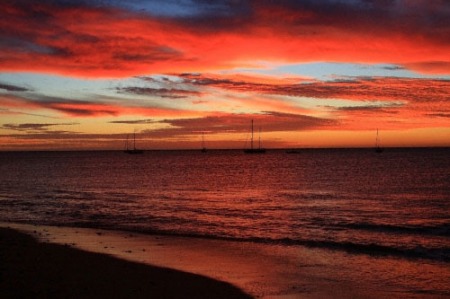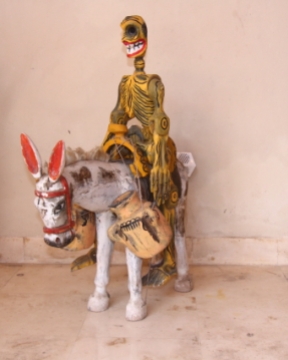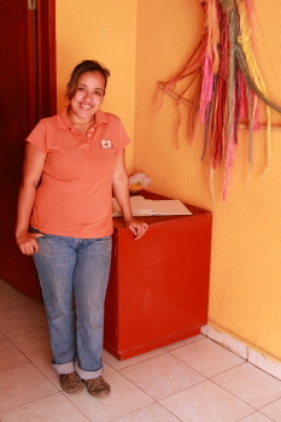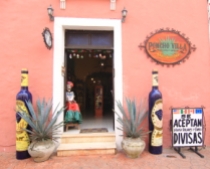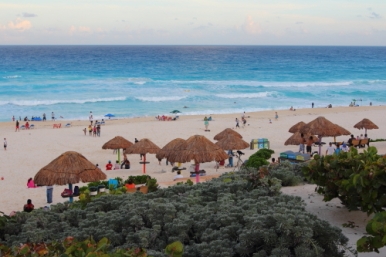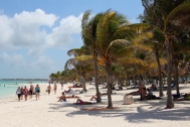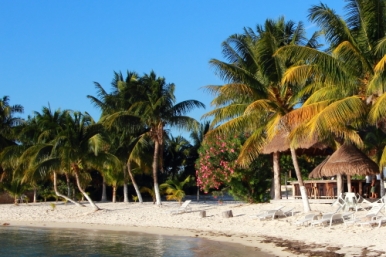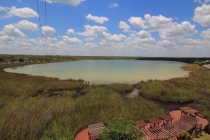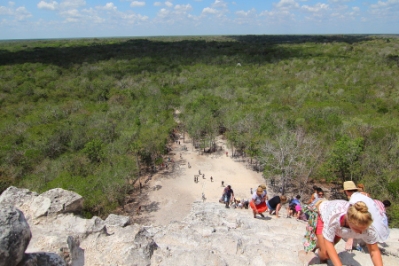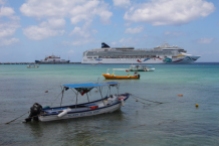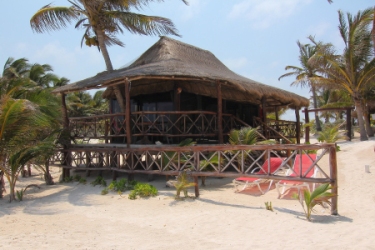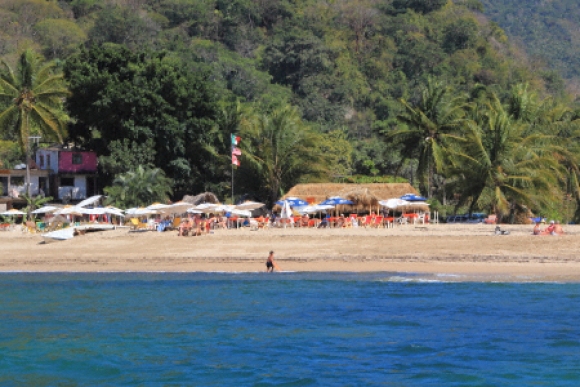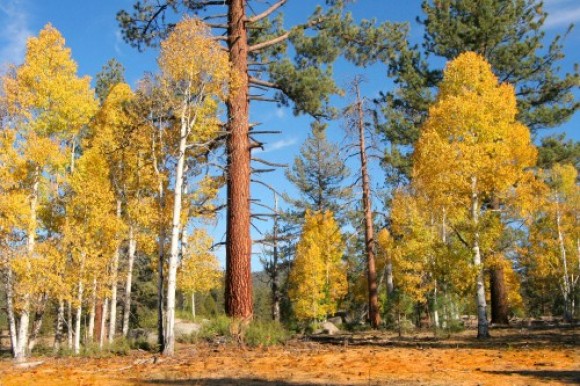Mexico is one of the top 5 countries in the world in terms of ecological diversity and is home to the Paricutin Volcano that is also one of the 7 natural wonders of the world. This is the result of Mexico’s topography which varies significantly and its geographic situation which places it between distinct eco-zones. There are many ways to enjoy these natural wonders found in Mexico including white water rafting, scuba diving, sailing, trekking, mountain climbing, bird watching, biking and a variety of other eco-activities. Naturally, there is some disagreement about which of mexico’s natural wonders are the best, so researchers have conducted surveys to determine which of these is most popular. Copper canyon was determined to be the most popular followed by Sumidero Canyon, the butterfly reserves and the meso american barrier reef..
Tag Archives: mexico
Day of the Dead, Lake Chapala, Mexico

A tribute to revolutionary hero’s Pancho Villa and Emiliano Zapata
The day of the dead is a long standing tradition in Mexico similar to Halloween or all saints day in other parts of the world and was inscribed into the intangible cultural heritage of humanity by UNESCO in 2008. In Mexico, it is also a national holiday celebrated on November 2nd. On this day Mexicans pay homage to deceased family members, friends, national hero’s, luminaries and even world leaders with personalized altars that offer gifts to the departed. These offerings usually include flowers, favorite foods, beverages and possessions of the dead. Alternately, family members will visit the grave site of departed souls and leave similar offerings.
Today , Katrina’s are the most highly recognized symbol associated with the Day of the Dead. Years ago, however, a Katrina referred to an elegant and well dressed woman of class and privilege until a mexican artist created an illustration of a well dressed skeleton during revolutionary times that was supposed to symbolized the death of mexico’s ruling class of privileged aristocrats. Eventually, the Katrina figure came to represent the joy of life in the face of its end.
Taxco, the Worlds Silver Capital

The Santa Prisca Cathedral was built in the 18th century with funds provided by the silver tycoon J0se de la Borda
Founded in 1529 by one of Hernan Cortes captains, Taxco remained an unkown village outside of Mexico until the discovery of a silver mother lode in the 18th century fueled the cities development. Sometime in the 1920’s as the silver mines were being played out, an American silversmith by the name of William Spratling came along and began teaching local people the art and science of silversmithing in his own workshop. The result was that the crafting of silver started a creative and economic boom that still exists today. Taxco now has over 300 silver shops including open air markets, metal workshops, and high end boutiques where buyers from around the world come to stock their retail stores with a variety of earrings, necklaces, rings and other creations .of silver finery. Besides the silver shops Taxco has other tourist attractions such as that old world ambiance of Spain with its winding cobblestone streets and small plazas, an aerial tram, good restaurants, some impressive architecture, Los Pozas Azules and several silver museums including the William Spratling museum dedicated to his contributions. For additional details, see the photo gallery below.
Grutas del Mamut, San Cristobal de las Casas, Mexico
The ecological site off Grutas del Mamut or Mammoth caves is about 7 km from the central historic area of San Cristobal. The main attraction here are the caves but the park also includes palapas with picnic tables, a pavilion for special events, snack bars, a soccer field, a river with canoe rentals, and a mountain top vista. The caves have several dimly lit rooms with some impressive stalactites and stalagmites. The stalactites are the formations that hang from the ceilings of caves while the stalgmites look like they emerge from the ground. Both are collectively referred to as drip-stones because they are formed through deposition of calcium carbonate and other minerals, which is precipitated from mineralized water solutions.The color of these drip-stones is determined by what minerals are dissolved in the formation process. The images below include both kinds of dripstones and other photo’s of this ecological site.
House of the Deer, Valladolid, Mexico

House of the Deer and one of 2 wet bars on the first floor of this house
Translated, the house of the deer is Casa de los Venados in Spanish. This is a privately owned collection of mexican folk and contemporary art in a home which is over 18,000 square feet and has more than 3000 pieces of museum quality art on display. Most of this art work has been acquired directly from the original artists over a 35 year period. The owners, John and Dorianne Venator, are originally from the United States where they have lived in both Chicago and Portland as well as their new museum/home in Valladolid.The Venators generously open their musuem/home to the public for tours at 10 a.m. everyday and it is free of charge. So, if you are ever visiting the maya riviera don’t miss the chance to tour this impressive, one of a kind display of art. The photo gallery below is just a small sample of the Venator’s art collection.
Valladolid, A Mexican Magic Town

The Cathedral of San Servacio
In August of 2012, Valladolid became part of Mexico’s “Pueblo Magico” program which recognizes traditional villages that meet their specific requirements of natural beauty, cultural riches, or historic relevance to the country. It is a well preserved colonial city of Spanish arcades and 16th century spires located between the beaches of Tulum and the archeological site of Chichen Itza. A few of the main attractions include the cathedral of San Servacio, Rosado Park, Cenote Zaci, the colonial homes with great architecture on Calzdada de Los Frailes and the Siskal neighborhood temple and ex-convent of San Bernadino de Siena. Additional activities include a variety of tours such as the chocolate factory tour, the mexican folk art tour of Casa de Venado and the Tequila tours of local agave plantations and distilleries. Photos and additional information is included in the photo gallery.
Chichen Itza, Mexico
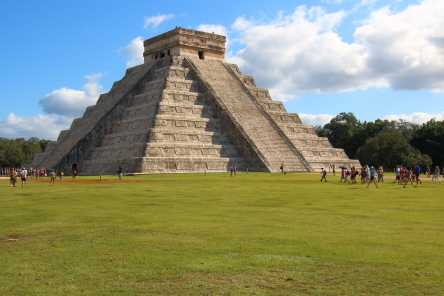
Temple of Kukulcan or El Castillo
Located in Yucatan near Valledolid, Chichen Itza has been a world heritage site since 1988 and has also been voted one of the world’s new seven wonders. The most dominant edifice at this archeological site is the Temple of Kukulcan, which happens to be the name of a maya feathered serpent deity. One of the most interesting facts about this pyramid more commonly known as El Castillo is that it is a monument of cosmological symbolism existing during this era. There are four sides containing 365 steps depicting the solar year, 52 panels for each year in the Mayan century as well each week in the solar year and 18 terraces for 18 months in the Maya religious year. Additional information about this archeological site is included in the photo gallery below.
A Taste of Playa

Playa del Carmen just finished celebrating an annual event known as a “Taste of Playa” on Sunday the 24th of November. It is a culinary event that highlights the best and most creative restaurants as well as retail food outlets that define the culture of this area.which is renowned for its diversity, international influences and culinary expertise. At the event which is open to the general public from 3 p.m. to 9 p.m. guest have a chance to sample a variety of food and beverages served at the many restaurants around town for a few pesos. This is a very convenient way to discover who’s serving your favorite foods at the right price without the hassle of shopping around town for days on end.
Day of the Dead, Xcaret Park

a headstone made of seashells
In 2003 the Day of the Dead was declared a masterpiece of oral and intangible heritage by U.N.E.S.C.O. and every year the Xcaret Park near Cancun, Mexico celebrates the Day of the Dead with a 5 day event known as the ” Festival de Tradiciones de Vida y Muerta”. During this celebration visitors can enjoy traditional cuisine of the region, workshops, handcrafts, visual art exhibtions, music, dances, rituals, altars, and offerings. One of the highlights of this event is the tour of their cemetery which is both a tribute to the deeply rooted attitudes of mexicans towards death and a replica of cemeteries found throughout Mexico. This cemetery is located inside the maya village on a hill with winding spiral paths that lead to the top.The path is lined with unique and imaginative headstones, plaques and ornamental structures that display a variety of spiritually oriented designs and attitudes about the dead.The photo gallery below is a sample of what to expect in the cemetery and in other locations around the park during this event.
Mexico and Monuments
Mexico loves it monuments and that’s why one of its most important cities, Oueretaro, was inscribed as a historic monument U.N.E.S.C.O. world heritage zone in 1996. A tourist in Mexico can learn much about the history of this country by simply visiting these monuments which can be found in most every large city and resort area. There are several kinds of monuments such as statutes built as a lasting tribute to a person, a group of people or an event. Other kinds of monuments that are most common can be either a place, building site or structure that is preserved because of its historic culture and/or aesthetic importance. In addition to Queretaro; most of the national monuments are found in Mexico city, Gaunajuato, and Guadalajara but there are many other significant monuments to be found in a variety of locations nationwide.The photo essay below shows a variety of these monuments including some of the most important and popular in Mexico.
Beaches in Mexico
Mexico has about 6,000 miles of coastline and over 450 beaches with a variety of physical characteristics. These range from desert to tropical environments but while it may be easy to classify beaches according to these objective characteristics, the choice of which beach resort is best for a vacation is much more subjective. A quick internet search will turn up several sites that rate beaches in Mexico by a variety of different criteria but there is only one objective system that rates beaches by strict criteria applied the world over and that site can be found at http://www.blueflag.org. Their system for evaluating beaches started in France around 1985 and is now run by the European Foundation for Environmental Education. In general, the Blue Flag criteria used to determine which beaches deserve to be awarded are water quality, safety, services, environmental management and information. As of now, there are 5 beaches that have earned the blue flag award in Mexico. Coincidently, all five of these beaches are also on the list of the best beaches in Mexico as published by websites such as Travelers Choice and magazines such as U.S News and Travel that use tourist opinions or travel writers opinions to rate beaches. So, if finding the best beach is a top priority on your next vacation, it comes down to a decision about the intangibles such as idyllic versus the tangibles such as environmental information signs. In the photo essay below there is a photo of Playa Delfines, a blue flag awarded beach, as well as several photos of beaches in Tulum which Travelers Choice rates as the best in Mexico. All other beach photos below are highly rated by one or more survey about best beaches in Mexico.
Mexican Ecosystems
A biome is a group of ecosystems that shares similar flora, fauna, microorganisms and climate. While an ecosystem is defined as the dynamic interactions between flora, fauna, microorganisms and their environment working together as a functional unit.The main difference between the two is that a biome consist of many similar ecosystems throughout the world grouped together. One of the problems encountered in the classification system of biomes and ecosystems is the transition zones that can make it difficult to determine exactly where one system begins and another ends. In any case,, roughly 29 percent of the land in Mexico is considered to be in desert or shrubland biomes while another 30 percent of the land consist of several different forest biomes. Additionally, Mexico is said to have 51 distinct ecosystems which makes it the most biologically diverse country in Latin American. For example, some of the ecosystems in the forest biomes of this country alone include coniferous forest, oak forest, tropical semi deciduous forest, mixed forest, cloud forest, deciduous forest and evergreen forest just to mention a few of the 51 possibilities. The photo essay below depicts a few of these ecosystems and includes additional information.
Eco-Sur Botanical Garden, Puerto Morales, MX
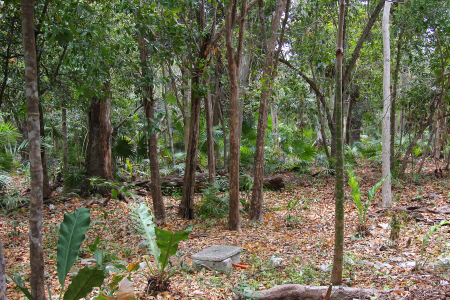
This 150 acre botanical garden also know as Ya’ax Che is the last patch of conserved forest between Cancun and Playa del Carmen. Established in 1982, the main objectives of the park are to preserve and propagate endangered plant species as well as inform and educate visitors about how the mayans used the natural resources of this area. To this end, there is an interpretive trail of about 4 km with a variety of exhibits set in a natural forest environment representative of the complete eco-system existing in the Yucatan Peninsula. The distinct exhibits consist of cactus, orchids, ferns, ornamentals, palms and medicinal plants, Additionally, there are maya ruins, a recreated traditional mayan home and “chicle camp” where sap from chicle trees was used to make the chewing gum which bears its name. Wild fauna such as spider monkeys, lizards and a variety of birds can also be seen along the trails. For more information and images about this park, see the photo essay below.
Coba, Maya Riviera
The archaeological site of Coba exists in a world that has changed very little in the past 1000 years or more. So, it is still surrounded by a natural environment of jungle vegetation, tropical hardwoods, lagoons, vines, and wildlife as far as the eye can see. Although the cities origins date back to the year 600 A.D. it was abandoned after the Spanish conquered the Yucatan Peninsula around 1550. Evidently, Coba was located in such a remote area in those days that the Spanish never found the city which remained hidden in the jungle until 1842 when it was rediscovered by explorers.
Coba is an expansive site which is believed to contain apporximately 6500 structures that once supported an estimated 45,000 people. At this time, however, only a small portion of Coba has been cleared from the jungle and restored by archaeologists. This part consist of 6 separate areas called the Coba Group, the Nohoch Mul Group, the Pinturas Group, the Chumuc Group, the Macanxoc Group and the Uitzil Mul Group which are all connected by a system of dirt roads built over a 1000 years ago. To see the ruins in these different areas you can either walk, rent a bike or a chofer driven tricycle. If your visiting Coba in the summer months it would be best to rent a bike or chofer driven tricycle and save your energy for climbing the Nohoch Mul pyramid, tallest in the Yucatan peninsula at 138 feet. Images of this pyramid and some of Coba’s other attractions along with additional information can be found in the photo gallery below.
Isla Cozumel, Mexico
Cozumel is the largest of Mexico’s islands measuring 53 km by 14km and is found in the Caribbean Sea about 1 hour away from Playa del Carmen on the passenger ferries which make frequent trips on a daily basis. Although, there are a variety of things to do once you get to Cozumel the main attraction has always been snorkeling and scuba diving to experience the great meso american reef system. One travel guide book has a list of 86 attractions around Cozumel but 43 of them involve different scuba diving or snorkeling locations. Other things to do while on the island are related to either cultural activities, parks or beach clubs.
Three types of beaches can be found around this island and they will be either rocky, smooth white sand or hybrids. According to people in the know, rocky beaches are a indication of good snorkeling opportunities off shore and they are plentiful. The smooth white sand beaches are not as common as the rocky type but they can be found at the northern or southern tips of the island’s western shores such as Playa San Francisco near Punta Sur. Finally, there is the hybrid variety where sand has been brought in to build a beach on top of the limestone croppings that are the norm around Cozumel.. One such man made beach is found at the Chankannab National Park to the south of town.
At the end of the day, most people head for San Miguel to enjoy happy hour, dinner or other cultural activites. This is the only city on the island and it has a population of over 75,000 people according to the last count. One of the main attractions here is the pedestrian only Plaza Centro where you can find restaurants, shops, street artist, cafe’s and nightlife. In the photo gallery below you will find images and more information about Plaza Centro, a few of the beaches as well as some other highlights.
Tulum, Maya Riviera
Tulum is a mixture of 3 separate and distinct areas which consist of the archeological zone, Tulum Playa and Tulum Pueblo. In the past, the main reason to visit Tulum was to see the archeological site but many new additions to both the beach zone and central zone are now attracting tourist for a variety of others reasons. The focus of new developments in the Tulum Playa area is overwhelmingly on eco-tourism and preservation of the natural environment. So, new construction projects are kept to a minimum and must also meet strict standards for sustainable development.
Tulum pueblo is primairily a business and residential area for the locals but it also has some restaurants and nightlife that appeals to both tourist and residents alike. The beach area, however, is the main attraction for most people and Tulum beach road is where it’s all happening. This is where you find all the new ecologically designed boutique and spa hotels along with beach clubs, beach parties, stores and a decent selection of restaurants and nightlife. This is the only way into and out of Tulum Playa and it is surrounded by jungle on one side and the caribbean on the other. This is the same road that leads to the Sian Ka’an Reserve and Punta Allen which is a fishing resort at the tip of the peninsula. In any case, someone once said “a picture is worth a thousand words” so, to learn more about Tulum Playa, see the photo gallery below.
Guadalajara, Mexico
The main attraction to Guadalajara, Mexico’s second largest city, is the well preserved central historic district. The centerpiece of this downtown area is the landmark Main  Cathedral with its twin 200 foot towers erected in 1848. It is surrounded by 4 distinct plaza’s named Plaza de Armas, Plaza Tapatia, Plaza de Liberacion and Plaza Guadalajara. All together they offer visitors a variety of shops, restaurants, cultural activities and events hard to find elsewhere in the country with the exception of Mexico city. One of the highlights located in the Plaza Tapatia is the Cabanas Cultural Institute
Cathedral with its twin 200 foot towers erected in 1848. It is surrounded by 4 distinct plaza’s named Plaza de Armas, Plaza Tapatia, Plaza de Liberacion and Plaza Guadalajara. All together they offer visitors a variety of shops, restaurants, cultural activities and events hard to find elsewhere in the country with the exception of Mexico city. One of the highlights located in the Plaza Tapatia is the Cabanas Cultural Institute  which houses art exhibitions, a movie theater, a performing arts theater and an outdoor patio where ballet and musical events take place.
which houses art exhibitions, a movie theater, a performing arts theater and an outdoor patio where ballet and musical events take place.
The Central Historic area of Gaudalajara is also a convenient base for exploring other surrounding attractions such as the suburb of Tlaquepaque and Tequila, a Unesco World Heritage sight where much of the countries national drink is produced.  Only a few minutes away from Gaudalajara’s downtown visitors can also experience the artisan community of Tlaquepaque, that produces the greatest variety of handicrafts in Mexico. Here, in a large pedestrian tourist area there are over 200 stores, restaurants, galleries and other attractions. Another unique experience not to be missed while in Guadalajara, is the tequila express, a 90 minute train ride from the station in Central Guadalajara that passes through vast fields of blue agave, the village of Tequila and finally arrives at the Casa Herradura Distillery. This train ride features plush coaches, live Mariachi music on board, tequila tastings and dinner at the Casa Herradura, one of the oldest tequila making facilities in the country which is still 100% Hacienda made.
Only a few minutes away from Gaudalajara’s downtown visitors can also experience the artisan community of Tlaquepaque, that produces the greatest variety of handicrafts in Mexico. Here, in a large pedestrian tourist area there are over 200 stores, restaurants, galleries and other attractions. Another unique experience not to be missed while in Guadalajara, is the tequila express, a 90 minute train ride from the station in Central Guadalajara that passes through vast fields of blue agave, the village of Tequila and finally arrives at the Casa Herradura Distillery. This train ride features plush coaches, live Mariachi music on board, tequila tastings and dinner at the Casa Herradura, one of the oldest tequila making facilities in the country which is still 100% Hacienda made.
Butterfly Migration to Mexico
 Monarch butterflies are not able to survive the cold winters in the United States or Canada, so like most birds they fly south for the winter. The migration usually begins sometime in October or as soon as the weather starts turning cold in North America. Monarch butterflies living east of the Rocky Mountains fly to Mexico and monarch’s living west of the Rockies fly to Southern California. Experts have not yet discovered how the monarchs can navigate to the same spots every year when no single butterfly can survive the roundtrip but most believe that flight patterns are inherited or they are capable of using the earth’s magnetic fields for orientation.
Monarch butterflies are not able to survive the cold winters in the United States or Canada, so like most birds they fly south for the winter. The migration usually begins sometime in October or as soon as the weather starts turning cold in North America. Monarch butterflies living east of the Rocky Mountains fly to Mexico and monarch’s living west of the Rockies fly to Southern California. Experts have not yet discovered how the monarchs can navigate to the same spots every year when no single butterfly can survive the roundtrip but most believe that flight patterns are inherited or they are capable of using the earth’s magnetic fields for orientation.
While in Mexico, the butterflies winter haven is found at the El Rosario Butterfly Reserve in the state of Michoacan. Here, the butterflies have an ideal combination of trees and plant food needed to survive until spring. It is estimated that 20 million monarchs stay in this place every year which is open to visitors interested in observing this natural event from November until late march when the northward migration from Mexico begins. As previously indicated, the length of these journeys exceeds the life span of a monarch, so the first generation will only make it as far as Texas or Oklahoma before the females need to deposit eggs for the next generation if the species is to survive. All together it requires 4 generations of monarchs to complete this annual migration pattern .
Canada de la Virgin, Archaeological Site
 Located about 18 miles from San Miguel de Allende is the archaeological site of Canada de la Virgin. It represents an important part of pre-hispanic mexican culture where many historical relics have been found. There are 7 pyramid structures of different sizes and styles that were built around 540 A.D. by Toltec and Chichimeca architects. According to experts, the site was designed and configured in such a way that all structures would be symmetrically aligned with cosmic cycles. Hence, this pattern of construction allowed the pyramids to serve as sky observatories among other things. In addition, Canada de la Vrigin is also part of a nature preserve offering a variety of recreational activities such as camping, hiking, horseback riding and astronomy tours, as well as a venue for special events.
Located about 18 miles from San Miguel de Allende is the archaeological site of Canada de la Virgin. It represents an important part of pre-hispanic mexican culture where many historical relics have been found. There are 7 pyramid structures of different sizes and styles that were built around 540 A.D. by Toltec and Chichimeca architects. According to experts, the site was designed and configured in such a way that all structures would be symmetrically aligned with cosmic cycles. Hence, this pattern of construction allowed the pyramids to serve as sky observatories among other things. In addition, Canada de la Vrigin is also part of a nature preserve offering a variety of recreational activities such as camping, hiking, horseback riding and astronomy tours, as well as a venue for special events.
Tropical Beaches of Puerto Vallarta
Along the shores of Banderas Bay, there are numerous beaches that are divided into three zones; north of town, in town, and south of town. Four of the most popular beaches south of Puerto Vallarta Central include Mismaloya Beach, Boca Tomatlan, Las Animas and Quimixto. Mismaloya and Boca Tomatlan can be reached by car, bus, or taxi but Las Animas and Quimixto can only be reached by boat or by hiking thru long jungle trails from Boca Tomatlan.
Mismaloya Beach is about 6 miles from the center of town and happens to be where ¨Night of the Iguana¨ starring Richard Burton was filmed in 1963 before the condo´s and hotel´s were constructed. More recently, much of the ¨The Predator¨starring Arnold Schwarzenegger was filmed in the jungle behind Mismaloya. Boca Tomatlan beach is about 10 miles from the center of town and is the last of the south shore beaches which can be reached by car. This beach lies at the the mouth of the Rio Horcones, so besides salt water there are fresh water pools for swimming, restaurants for other kinds of refreshment and water taxi´s for trips to the other beaches not accessible by car. The boat ride from here to Las Animas or Quimixto is only a short distance and relatively inexpensive. At Las Animas, there is an adventure park with zip lines, rope bridges and climbing activities. The main attraction at Quimixto is a 30 meter high waterfall which feeds into a natural pool of pristine mountain water about 15 meters deep and can be reached by horseback or by hiking across several hills and 2 rivers. Both of these beaches offer a variety of restaurants and shops that sell locally made merchandise.
Puerto Vallarta, Mexico
Vallarta is located on the pacific coast of Mexico at the foot of the Sierra Madre mountains. It is an alluring blend of modern sophistication and old world character with many luxury resorts fronted by beaches and the warm waters of Bandaras Bay. Despite the presence of luxury hotels and condominiums, Puerto Vallarta remains a very casual resort where shorts and t-shirts are standard attire.
Although Vallarta started attracting tourist in the 1940´s, it was the filming of ¨The Night of the Iguana¨, starring Richard Burton in 1963 that eventually put Puerto Vallarta on the international tourist map to stay. With the development of the Marina Vallarta Complex in the mid 90´s, the city has also become a major port of call for cruise lines. As a result, American discount chains such as Walmart and Costco have set up shop to accommodate the growing population of ex-pats and tourist that come by land or sea.
Since Banderas Bay is protected by its shape and surrounding geography, the water remains calm and clear most of the time. So, conditions are ideal for many water sports such as boating, deep sea fishing, snorkeling and parasailing. Other popular recreational opportunities in the area include golf, tennis and a variety of eco-tours into the Sierra Madre mountains for the more adventurous.
The Art Institute of San Miguel de Allende, Mexico
San Miguel de Allende may be a tourist town but what attracts visitors to this area is the atmosphere created by the art institute and all its related activities. Although the art institute was created around 1950 by Enrique Martinez, a former governor of Guanajuato, his wife Nell Harris, a retired Naval Officer named Sterling Dickinson and Peruvian artist and diplomat Cossio del Pomar, everyone seems to agree, that Sterling Dickinson is most responsible for San Miguel becoming an international art center.
Initially, the art institute offered a master´s in fine art accredited by the University of Guanajuato but over the years the institute has grown in size and scope and now offers BA and AA degrees in the visual arts along with workshops in painting, drawing, jewelry, weaving, photography and more. Additionally, there are many spanish language learning
programs and an art school for children.
The Sierra Laguna Bioshpere Reserve in Mexico
The Sierra Laguna mountain range is located in the cape region of Baja California Sur and as a bioshpere reserve this area is a protected environment which prohibits development. At higher elevations, the sierra laguna´s also qualify as a cloud forest during the summer months when the peaks are consistently shrouded in mist or rain. This type of climate supports a mix of desert, tropical and sub-alpine flora which are unique in North America. Likewise, a variety of fauna such as deer, coyote, tree frogs and mountain lions can also be found in this area. As a result, the Sierra Laguna´s are a popular destination for hikers and backpackers who come to enjoy the impressive scenery which surrounds the numerous mountain trails of this reserve.
San Pedro Martir National Park, Mexico
Located in Baja California about 3 hrs drive southeast of Ensenada is the Parque National Sierra San Pedro Martir which was founded in 1947. It is about 170,000 acres and has a variety of flora and fauna similar to the Sierra Nevada mountain range in the USA. As visitors start the ascent to this national park off the main highway from Ensenada the terrain changes rapidly from arid coastal plains, to high chaparral and once above 1500 meters it becomes thickly forested glens with many trails and campsites for hikers and backpackers. In addition to a recreational area, the Mexican government selected this site for its national observatory and largest telescope because of its exceptionally clean air.
Bahia Pulmo, Baja Sur, Mexico
Bahia Pulmo is both a national marine preserve and UNESCO world heritage site found on the East Cape of Baja California Sur about 60 miles from the Los Cabos resort area of Mexico. Bahia Pulmo is unique in that it has the only hard coral reef in the sea of cortez and is one of only 3 living reefs in North America. The abundant coral growth on the rocky reefs provides plenty of shelter for a variety of colorful reef fishes, many of which are not found anywhere else. This in turn is what attracts many scuba divers and snorkelers from all over the world to the Cabo Pulmo area.
Bahia Concepcion, Baja California Sur, MX
Bahia Concepcion is located on the East Coast of Baja California Sur, Mexico. The entire bay is a national marine preserve that is reportedly one of the cleanest bay systems in the world and commercial fishing is prohibited. However, it is ideal for anglers, small boats, windsurfers, divers and kayakers. The bay area attracts many visitors from the USA, Canada, and Europe who usually stay in tents, palapa huts or motor homes since motels are few and far between. These photos show just a few of the many beaches in the bay area including Playa El Requeson, Playa El Coyote and Playa Los Cocos.
Mexico hosts LatAms largest balloon festival

Mexico hosts Latin Americans largest balloon festival and it is located in the city of Leon where the skies are filled with several hundred balloons over a three day period. This is an annual event which is held around the 3rd week of November. In addition to the colorful balloons; the event is packed with exhibitions, presentations, and live music concerts.
La Pena de Bernal, Mexico

worlds 2nd tallest monolith in the shrubland environment of Queretaro
At 350 meters, Pena de Bernal is the third tallest monolith in the world. It is located near Queretaro, Mexico in the small village of Bernal. Also known as one of Mexico’s “Pueblo Magico’s” or magic towns because of its historic charms, closeness to a major city and peaceful atmosphere.
Hill of Bells, Queretaro, Mexico

A chapel monument located on the hill in Queretaro where the Mexican army defeated Maximillian to win freedom from Austria.
This chapel sits on a hill which was the scene of a defining moment for the republic of Mexico. Here, on June 19, 1867; the verdict of the war tribunal was carried out when Maximillan of Hapsburg together with his generals Miguel Miramon and Tomas Mejia were executed by a firing squad. This act sealed the triumph of the Republic and returned sovereignty to Mexico. In 1900 the government of Austria asked permission to build a chapel on the spot. Today this hill is a national park called Cerro de las Campanas and is located in the city of Queretaro. It also includes a large statute of former President Benito Juarez, a museum, the University of Queretaro, and a recreation area.

